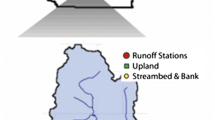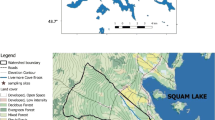Abstract
Lake Tahoe is undergoing the initial stages of culturaleutrophication due to human alteration of the airshed andwatershed. The lake's switch from nitrogen (N) to phosphorus (P)limitation has been attributed primarily to atmospheric Nloading. This places an increased importance on controllingwatershed movement of P to the lake. A stream water qualitymonitoring data set consisting of nine streams in the Lake Tahoebasin has been analyzed to characterize the spatiotemporalvariation of P delivery to the lake. This data is from the LakeTahoe Interagency Monitoring Program (LTIMP), which providesscientific data for planning and regulatory agencies to addressenvironmental problems in the Lake Tahoe basin. Results indicatethat P delivery (concentrations, loads) varies greatly atinterannual, seasonal, and spatial scales. Annual and seasonaltotal P (TP) concentrations can vary up to three orders ofmagnitude in a given stream and are strongly associated withsuspended sediment. Particulate P is the major form of Ptransported by Tahoe streams and was strongly correlated withpercent surficial geologic deposits, which are primarily locatednear streams. Tahoe streams with the highest annualP concentrations often had the lowest annual P loads, and visaversa. P loading is greatest during the spring snowmelt (75% ofannual average). Potential watershed parameters influencing Pdelivery to Lake Tahoe have been identified as precipitation,basin area, basin steepness, and road and human developmentcoverage. Results also suggest that human development impacts onstream P loads are most prevalent during high precipitationyears. Identification and quantification of stream sediment andP sources such as streambanks and impervious surface isnecessary to aid in watershed restoration efforts.
Similar content being viewed by others
References
Bailey, R. G.: 1974, Land-capability classification of the Lake Tahoe basin, California-Nevada, Tahoe Regional Planning Agency, Zephyr Cove, NV. pp. 32.
Beaulac, M. N. and Reckhow, K. H.: 1982, Wat. Res. Bull. 18, 1013–1024.
Chikita, K. A.: 1996, J. Hydrol. 186, 295–313.
Dedkov, A. P. and Moszherin, V. I.: 1992, in Erosion, Debris Flows, and Environmental in Mountain Regions (Proceedings of the Chengdu Symposium, July 1992) IAHS Publ. 209. pp. 29–36.
Dillon, P. J. and Kirchner, W. B.: 1975, Water Res. 9, 135–148.
Dillon, P. J., Molot, L. A. and Scheider, W. A.: 1991, J. Env. Qual. 20, 857–864.
Farrar, J. W. and Long, H. K.: 1996, Report on the U.S. Geological Survey's evaluation program for standard reference samples distributed in October 1995: T-137 (trace constituents), M-136 (major constituents), N-47 (nutrient constituents), N-48 (nutrient constituents), P-25 (low ionic strength constituents) and Hg-21 (mercury), U.S. Geological Survey Open-File Report 96–138, Golden, CO.
Fenn, C. R. and Gomez, B.: 1989, Hydol. Proc. 3, 123–125.
Ferguson, R. I.: 1986, Wat. Resour. Res. 22, 74–76.
Gaynor, J. D.: 1979, J. Great Lakes Res. 5, 124–130.
Glancy, P. A.: 1977, A reconnaissance of sediment transport, streamflow, and chemical quality, Glenbrook Creek, Lake Tahoe basin, Nevada (Nevada Highway Department Hydrologic Report 2), pp. 54.
Glancy, A.: 1988, Streamflow, sediment transport, and nutrient transport at Incline Village, Lake Tahoe, Nevada, 1970–1973 (U.S. Geological Survey Water-Supply Paper 2313), pp. 53.
Goldman, C. R.: 1974, Eutrophication of Lake Tahoe emphasizing water quality, U.S. Environmental Protection Agency, NTIS, EPA Report 660/3–74–034.
Goldman, C. R.: 1988, Limnol. Oceanogr. 33, 1321–1333.
Goldman, C. R.: 1993, Standard operating procedures: UC Davis Limnological Laboratory, University of California, Davis, pp. 69.
Goldman, C. R., Jassby, A. D. and Hackley, S. H.: 1993, Can. J. Fish. Aquat. Sci. 50, 1489–1496.
Grober, D. and Silberbauer, M.: 1985, Water Res. 19, 975–981.
Guy, H. P.: 1969, Laboratory theory and methods for sediment analysis. U.S. Geological Survey – Techniques of Water – Resources Investigations Book 5, Chapter C1, pp. 58.
Hatch, L. K.: 1997, The generation, transport, and fate of phosphorus in the Lake Tahoe ecosystem, Ph. D. Thesis, University of California at Davis, pp. 212.
Heyvaert, A.: 1998, The biogeochemistry and paleolimnology of sediments from Lake Tahoe, California-Nevada, Ph. D. thesis, University of california at Davis.
Hill, B. R, and Nolan, K. M.: 1990, pp. 179–189, in Proceedings: International Mountain Watershed Symposium, June 8–10, 1988, Lake Tahoe, Tahoe Resource Conservation District, South Lake Tahoe, California, pp. 610.
Hunter, D. A.: 1996, Lake Tahoe Interagency Monitoring Program Water Chemistry Water Quality Control Report, January-June 1996, Tahoe Research Group, University of California at Davis, pp. 7.
Hunter, D. A., Reuter, J. E. and Goldman, C. R.: 1993, Quality assurance manual: Lake Tahoe Interagency Monitoring Program, Tahoe Research Group, University of California at Davis pp. 34 plus appendices.
Jassby, A. D., Reuter, J. E., Axler, R. P., Goldman, C. R. and Hackley, S. H.: 1994, Water Resour Res. 30, 2207–2216.
Jassby, A. D., Goldman, C. R. and Reuter, J. E.: 1995, Arch. Hydrobiol. 135, 1–21.
Jassby, A. D., Goldman, C. R., Reuter, J. E. and Richards, R. C.: 1999, Limnol. Oceanogr. 44, 282–294.
Jones, J. and Bachmann, R.: 1976, Journal WPCF, 48, 2176–2182.
Kaplan, L. A., Goldman, C. R. and Knight, A. W.: 1975, Bull. Ecol. Soc. Am. 56, 24.
Keller, H. M. and Strobel, T.: 1982,Water and nutrient discharge during snowmelt in subalpine areas, pp. 331–341 in Hydrological Aspects of Alpine and High Mountain Areas (Proceedings of the Exeter Symposium, July 1982), IAHS Publ. 138.
Leonard, R. L., Kaplan, L. A., Elder, J. F., Coats, R. N. and Goldman, C. R.: 1979, Ecol. Monogr. 49, 281–310.
Lewis, W. M., Saunders, J. F., Crumpacker, D. W. and Brendecke, C. M.: 1984, Eutrophication and land use: Lake Dillon, Colorado, Ecological Studies Series Vol. 46, Springer-Verlag New York.
Majanovic, P.: 1989, Mathematical modeling of eutrophication processes in Lake Tahoe: water budget, nutrient budget, and model development, Ph. D. Thesis, University of California at Davis, pp. 385.
Matthews, R. A. and Burnett, J. L.: 1971, Geology and land use planning in the Lake Tahoe basin, pp. 5–22 in Geology and geomorphology of the Lake Tahoe region: a guide for palnning, Tahoe Regional Planning Agency, Zephyr Cove, Nevada, pp. 59.
Menzel, D. W. and Corwin, N.: 1965, Limnol. Oceanogr, 10, 280–282.
Meyer, J. L.: 1979, Limnol. Oceanogr. 24, 365–375.
Meyer, J. L. and Likens, G. E.: 1979, Ecology, 60, 1255–1269.
Molot, L. A., Dillon, P. J. and Lazerte, B. D.: 1989, Can. J. Fish. Aquat. 46. 1658–1666.
Murphy, J. and Riley, J. P.: 1962, Anal. Chim. Acta 27, 31–36.
Perkins, M. A.: 1976, The influence of epiphytic periphyton upon phosphorus flow in a subalpine stream, Ph. D. Thesis, University of California at Davis, pp. 186.
Reuter, J. E., Jassby, A. D., Majanovic, P., Heyvaert, A. C. and Goldman, C. R.: 1998, Preliminary phosphorus and nitrogen budgets for Lake Tahoe, in Annual Progress Report – Lake Clarity and Watershed Modeling, John Muir Institute for the Environment, University of California, Davis, pp. 28.
Skau, C. M., Brown, J. C. and Nadolski, J. A.: 1980, Snowmelt sediment from Sierra Nevada headwaters, pp. 418–429 in Symposium on Watershed Management 1980, Vol. 1 (American Society of Civil Engineers, Boise, ID July 21–23, 1980, pp. 597.
Svendsen, L., Kronvang, B., Kristensen, P. and Graesbol, P.: 1995, Hydrol. Proc. 9, 119–142.
Tahoe Regional Planning Agency: 1982, Emvironmental Thresholds Study, TRPA, Zephyr Cove, NV.
Tahoe Regional Planning Agency: 1996, personal communication with land use and water quality staff members, TRPA, Zephyr Cove, NV.
USDA Forest Service: 1994, Blackwood CreekWater Quality Monitoring Report,Water Years 1980– 1993 (USDA Forest Service, Lake Tahoe Basin Management Unit, January 1994), pp. 52.
Vaithiyanathan, P. and Correll, D.: 1992, J. Environ. Qual. 21, 280–288.
Van Niewenhuyse, E. and Jones, J.: 1996, Can. J. Fish. Aq. Sci. 53, 99–105.
Walling, D. E.: 1983, J. Hydol. 65, 209–237.
Ward, A. D. and Elliot, W. J.: 1995, Environmental Hydrology, CRC Press, Inc., (Lewis Publishers, Boca Raton, FL), pp. 462.
Yaksich, S. M., Melfi, D. A., Baker, D. B. and Kramer, J.W.: 1985, J. Great Lakes Res. 11, 117–131.
Author information
Authors and Affiliations
Corresponding author
Rights and permissions
About this article
Cite this article
Hatch, L.K., Reuter, J.E. & Goldman, C.R. Stream Phosphorus Transport in the Lake Tahoe Basin, 1989–1996. Environ Monit Assess 69, 63–83 (2001). https://doi.org/10.1023/A:1010752628576
Issue Date:
DOI: https://doi.org/10.1023/A:1010752628576




